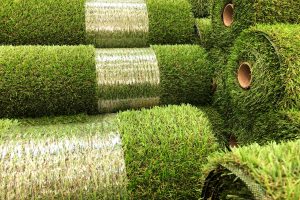Broadleaf Carpetgrass – Is It the Right Grass for You?
This perennial warm-season grass is an appealing choice for homeowners in tropical parts of Australia – especially northern Queensland. With excellent shade but poor drought ...

When it comes time to install a lawn that you and your family can enjoy and that best suits your lifestyle, the decision for some can start by asking whether they have the time and energy to dedicate themselves to a natural lawn, or if an artificial lawn might best suit their needs?
Artificial turf technology has come along in leaps and bounds in recent years, making it cheaper and more accessible than ever before. However, while it does have some benefits, there’s a long list of redeeming features of natural turf that make it the country’s favourite way to fill a yard, and should make natural turf your first choice, too.

There are several layers to Artificial Turf including the fibres, thatching, base material, backing material and infill, and as the name would suggest, every layer is made up of engineered synthetic materials.
It’s not uncommon for the fibres and thatching to be made from polyethylene, polypropylene or nylon, and they’re typically woven or glued to a dense rubber base that helps with structural integrity, but also some cushioning.
The infill material is usually a kiln-dried or otherwise sterilised fine grain sand that’s brushed into the canopy to help with the natural feel, add weight to the turf and assist with drainage.
In Australia, synthetic turf must meet certain standards to ensure safety, durability, and suitability for domestic use. Homeowners should check for certifications and warranties before installation to ensure they are investing in a quality product.
Natural turf plays a vital role in carbon sequestration, absorbing carbon dioxide from the atmosphere and releasing oxygen. A well-maintained lawn can also help to cool the surrounding environment, reducing the urban heat island effect. Additionally, natural grass acts as a natural water filter, helping to reduce runoff and improve groundwater quality.
Few things can match the lush, vibrant appearance of a natural lawn. The texture, colour, and seasonal changes of natural turf create a dynamic, living landscape that enhances curb appeal and provides a welcoming space for family and friends.
Natural turf contributes to healthy soil by supporting microbial activity and allowing the ground to breathe. It provides a habitat for insects, birds, and other wildlife, fostering biodiversity. Over time, a natural lawn can improve soil structure and fertility, enhancing the overall health of your garden.
Walking barefoot on natural grass has been shown to reduce stress and promote relaxation. It also absorbs heat, unlike artificial turf, which can become uncomfortably hot under the Australian sun. For families with children or pets, natural turf provides a safer and cooler surface for play.
While natural turf requires regular maintenance, it avoids the environmental drawbacks of artificial turf, such as the use of non-biodegradable plastics and the potential for microplastic pollution. Over its lifespan, natural grass can be a more sustainable choice with a lower carbon footprint.
As well as being cheaper to install than an artificial lawn, a well-maintained natural lawn can increase the value of your property as many buyers prefer the authenticity and charm of real grass. It also provides a renewable and self-sustaining landscape solution when properly cared for.
Installation costs are where we start to see the gap widen between natural and artificial turf, and the financial outlay will be determined by the area you’re looking to cover.
We’ve recently published a comprehensive guide to the Cost of Natural Turf, broken down by grass type, but costs can vary from $8/m2 to $27/m2 for more premium or modern varieties.
Don’t forget to factor in your turf underlay when calculating the costs of installing natural turf, or a quality starter fertiliser like LawnPride’s Under Turf Starter.
Artificial turf will cost more to install, with prices ranging between $60-120/m2 for material alone depending on the quality of the grass and the length of the pile. You’ll also need to factor in surface preparation, installation costs and the infill material (typically sand).
These costs can be amortised over the life of the turf as there are far fewer costs in terms of maintenance, and no ongoing fertilisation requirements like a natural lawn.
Artificial turf typically lasts 10-15 years, while a natural lawn, with proper care, can thrive indefinitely. Over time, the cumulative cost of replacing artificial turf may exceed the maintenance expenses of natural grass.
It could be argued that artificial turf requires less ongoing maintenance than a natural lawn, but the high initial installation costs combined with the long-term implications of more plastics in the environment (particularly disposing of the artificial turf ethically at the end of its life) make natural turf the clear winner for Australian yards.
Chat to your local myhomeTURF Turf Supplier about the perfect myhomeTURF variety for your yard.
.